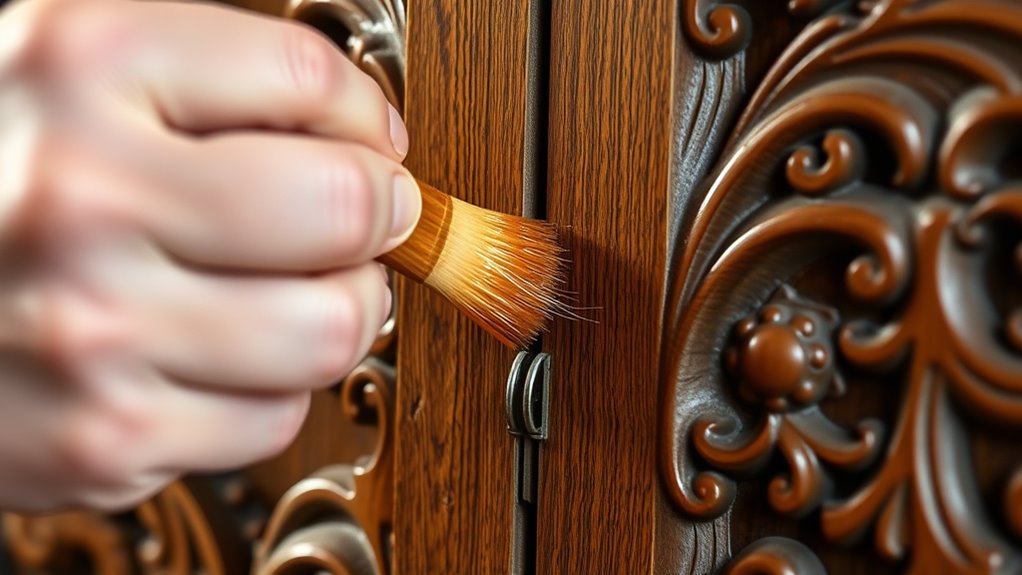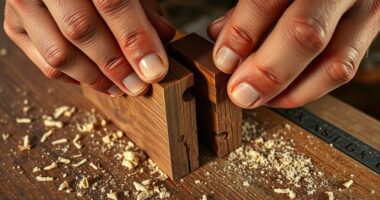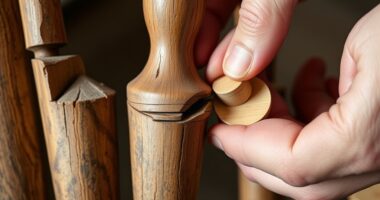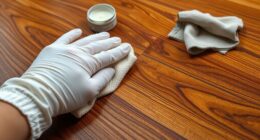Using hide glue in furniture restoration offers many benefits. It creates strong, durable bonds that are also reversible with heat and moisture, making repairs easier without damaging your piece. Its traditional qualities allow for precise application, preventing excess and ensuring seamless joints. Plus, because it’s been trusted for centuries, it’s ideal for preserving the authenticity and integrity of antique furniture. Keep exploring to discover how this age-old glue continues to enhance craftsmanship today.
Key Takeaways
- Hide glue provides strong, durable bonds that are easy to reheat and adjust during restoration.
- Its reversibility allows for careful dismantling without damaging original materials or veneers.
- Traditional and time-tested, hide glue maintains the authenticity of antique furniture.
- It offers precise application, reducing excess glue and ensuring seamless, clean joints.
- Using hide glue preserves the integrity of historic pieces while facilitating future repairs.
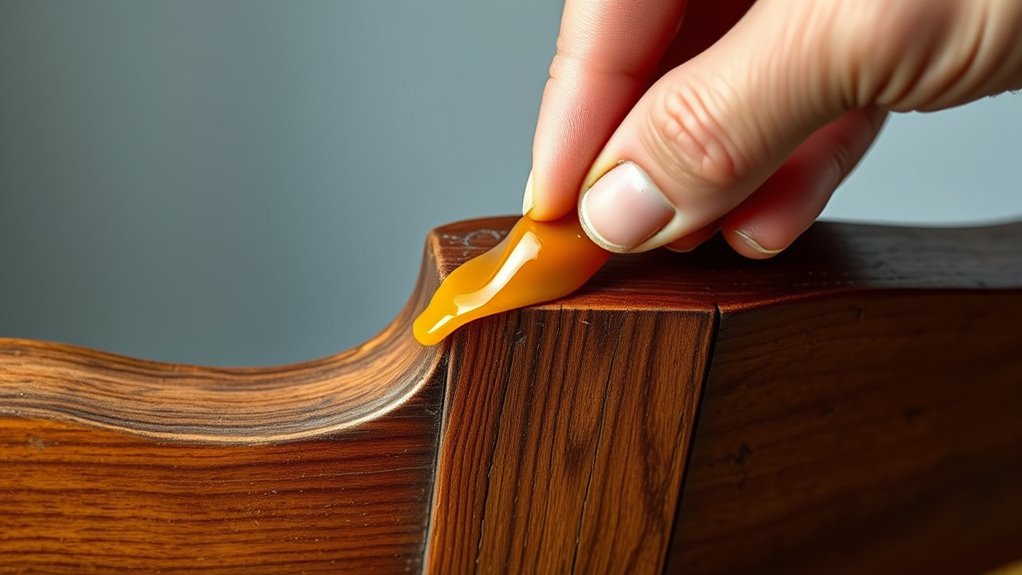
Hide glue offers several advantages that make it a popular choice for woodworking and restoration projects. When you choose hide glue, you’re opting for a traditional adhesive that has stood the test of time. Its ease of use, reversibility, and strength make it ideal for delicate furniture repairs and authentic restorations. One of the key benefits is its unique application techniques. Applying hide glue involves heating it until it reaches a liquid state, allowing you to brush or spread it onto surfaces with precision. This controlled application ensures tight joints without excess glue, which is critical when restoring antique furniture. Once applied, the glue bonds quickly and forms a durable, seamless joint. You can also adjust the amount of moisture and heat to control the open and setting times, giving you greater flexibility during the repair process. Additionally, hide glue’s ability to be reactivated with heat and moisture makes repairs and adjustments straightforward, especially if future repairs are needed. This reversibility is a major advantage over modern synthetic adhesives, which can be difficult to remove or may damage original materials.
The historical significance of hide glue cannot be overstated. It has been used for centuries, dating back to ancient Egypt and China, and remains a essential part of traditional woodworking. When you work with hide glue, you’re engaging in a craft that connects you with centuries of craftsmanship. It was the adhesive of choice for master furniture makers and restorers through the ages because of its reliable bonding and compatibility with natural materials like wood and bone. Its use in restoring priceless antiques preserves the original integrity of the piece while providing a strong, flexible bond. Using hide glue in restoration respects the historical techniques and maintains the authenticity of the furniture. This reverence for tradition isn’t just about preserving the past; it’s about ensuring that your restoration work remains true to the original craftsmanship. The glue’s ability to be heated and softened means restorers can dismantle or re-glue joints without damaging the wood or veneer, which is essential in preserving valuable or fragile furniture pieces.
Frequently Asked Questions
How Long Does Hide Glue Typically Last in Furniture?
You might wonder how long hide glue lasts in furniture. Typically, it can last for decades if applied properly, as it ages well with the wood. Its glue longevity depends on factors like wood aging and environmental conditions. Properly maintained, hide glue bonds remain strong and reversible, making it ideal for restoration. You’ll find that its durability often surpasses synthetic adhesives in historic furniture, ensuring lasting repairs.
Is Hide Glue Suitable for Outdoor Furniture Repairs?
You might worry that hide glue isn’t suitable for outdoor furniture, but it actually offers good outdoor durability when applied correctly. With proper sealing and finishing, hide glue provides decent weather resistance, making it a viable option for outdoor repairs. Its strong bonds and easy reversibility also make it a practical choice. Just guarantee you protect the repaired area from excessive moisture to maintain its longevity and outdoor performance.
Can Hide Glue Be Used on Modern Composite Materials?
You can use hide glue on some modern composite materials, but it’s not always ideal. Synthetic adhesives often provide better composite material compatibility, especially for plastics or engineered surfaces. Hide glue works well on traditional wood and porous materials, but for composites, you should verify the manufacturer’s recommendations. If you opt for hide glue, test a small area first to ensure proper bonding, as some composites may not respond well.
What Safety Precautions Should Be Taken When Handling Hide Glue?
When handling hide glue, you should wear appropriate safety gear like gloves and eye protection to prevent skin and eye irritation. Make certain proper ventilation requirements are met by working in a well-ventilated area to avoid inhaling fumes. Avoid skin contact and inhalation of steam or vapors, and handle hot glue carefully to prevent burns. Always follow manufacturer instructions for safe storage and disposal of hide glue.
Does Hide Glue Require Special Tools for Application?
Think of applying hide glue as painting with a fine brush—you don’t need special tools, just the right ones. For application techniques, a warm brush or spatula works well, and you’ll want a glue pot or a simple double boiler to keep it at the right consistency. Basic tools like brushes and scrapers are enough; no fancy equipment is required, making it accessible even for beginners.
Conclusion
In conclusion, choosing hide glue for furniture restoration offers unmatched reversibility and strong bonding, making repairs easier and preserving the piece’s integrity. Did you know that hide glue has been used for over 2,000 years, showcasing its durability and trusted performance? By opting for hide glue, you’re respecting traditional craftsmanship while ensuring your furniture stays beautiful and functional for generations. Embrace its benefits and give your restoration projects a timeless, authentic touch.
